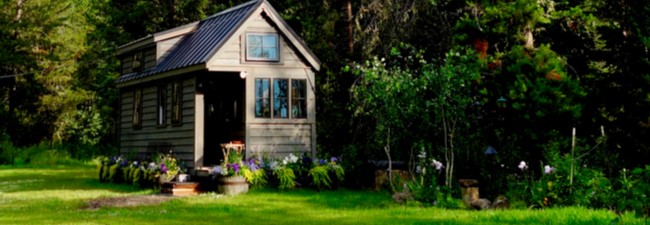New Page
Friday, February 19, 2021 - Tiny Homes Can Offer Huge Potential

Whether you’re trying to break into the real estate market, downsizing from a larger home or longing for more space for your growing family, there’s probably a tiny house for you. In addition to the trendy appeal to build a compact house on wheels and live an adventurous nomadic lifestyle, living large in a tiny house offers up a wealth of options–and their popularity is surging.
Canadians are curious
The Canadian Real Estate Association has reported record sales activity over the last few months as Canadians’ desire for more privacy, extra space and easy access to the outdoors has reached new heights. While for many this means larger homes in rural and suburban communities, for some, it means turning to tiny homes.
A recent study about Canadian real estate trends conducted by data provider SEMrush revealed consumers are more interested in smaller properties than they were in 2019. Searches for ‘tiny homes’ have increased by 55% since January. For people on a budget looking to stretch their home buying dollar, putting up a custom-built tiny home on a small parcel of land–especially in a rural area–offers lots of possibilities.
That said, despite their small size, tiny homes are faced with some big hurdles regarding where they’re located and how they’re built. With mixed regulations across Canada, it’s important to research your local zoning laws and building requirements before you start building.
Be sure to consider:
limitations to square footages in a rural community versus an urban neighbourhood;
the pros and cons of a mobile home built on wheels versus those of a stationary structure with a foundation; and
facility requirements based on location and type of tiny home (such as service connections for water and electric).
Tiny houses still occupy a grey zone between being a recreational vehicle (RV) and a traditional detached home—if you’re unclear about the regulations in your area, contact your municipality to learn more. Or ask your local REALTOR® for their insight.
A multi-functional space
Working from home, online schooling and the return home of college students due to the pandemic are also sparking the surge in tiny house research. After all, adding a pre-fab tiny home into your yard can add valuable and affordable square footage for an office, guest room, home gym or yoga studio, a pool house and many other uses, says Elizabeth Soutar, a REALTOR® and salesperson with Redline Properties in Brantford, Ontario.
“As a mom of three kids with a dog, I own a business, my husband owns a business and we need a quiet place. And I find a lot of my clients are saying the same thing,” says Soutar. “It’s not really worth moving over, because it’s such a hot market that you have to pay $100,000-$200,000 to upgrade just to get that extra 700 square feet.”
And at a fraction of that cost, you can do a lot with the added space a tiny home provides. Embrace your inner minimalist and find creative ways to maximize the room inside your humble abode:
use the walls efficiently to create a clutter-free kitchen by hanging as many items as you can;
add narrow shelving to any wall that isn’t serving a practical purpose;
consider flexible furniture such as Murphy wall beds and foldable tables and benches;
utilize sliding walls to avoid the inconvenience of permanent partitions; and
save space with loft beds and add storage beneath the stairs.
The perfect layout for your tiny home is a seamless blend of function and fashion, with the only limit being your imagination. If you’re looking for interior design ideas, there’s no shortage of inspiration on Pinterest—Tiny Living has some amazing designs highlighted on their account!
An affordable choice
Tiny homes can also be a cost-effective, simple solution, she notes. You can order a prefabricated unit–such as a recycled shipping container or another type of modular mini-home–and have it installed right onto your land.
“It’s also way easier, and cheaper than building an extension onto your house–a storage container only costs about $16,000,” says Soutar. “They’re built off-site and then delivered and hooked up. So, there’s less interruption into your daily life, because it’s not interfering with the actual interior of your house, which is a major advantage as well.”
A potential rental unit
Tiny homes can also bring in much-needed extra income, adds Soutar. In municipalities that allow it, a separate structure on your property that’s plumbed and wired to code can become a rental unit.
“Because it doesn’t have to be occupied by the owner, it could be rented out to family, to friends, or as a short-term or long-term rental,” says Soutar. “Ontario is trying to implement more housing options, so I think tiny homes will gain more traction for that in the spring and summer of 2021.
Thinking outside the box
Across North America, people are getting creative with small structures, and Soutar’s clients are also taking advantage of the trend, she adds.
“I know someone who’s thinking about buying a vacant lot and then building two tiny homes. If you have a 60-foot frontage, you could put two tiny homes on a property because they’re only 20-feet wide, and you could live in one and rent one,” she suggests.
Of course, tiny homes aren’t ideal as full-time dwellings for large families with three or more children–unless you put a few of them together–but for singles, couples, smaller families and empty-nesters, there are limitless possibilities for expanding your space, helping boost your property’s resale value, or earning a side income.
Source CREA Jan 2021